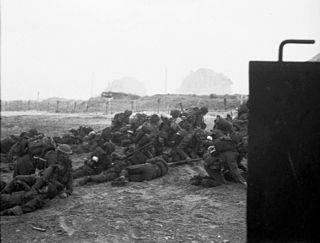
Sword, commonly known as Sword Beach, was the code name given to one of the five main landing areas along the Normandy coast during the initial assault phase, Operation Neptune, of Operation Overlord. The Allied invasion of German-occupied France commenced on 6 June 1944. Stretching 8 kilometres (5.0 mi) from Ouistreham to Saint-Aubin-sur-Mer, the beach proved to be the easternmost landing site of the invasion after the abortion of an attack on a sixth beach, code-named Band. Taking Sword was to be the responsibility of the British Army with sea transport, mine sweeping and a naval bombardment force provided by the British Royal Navy as well as elements from the Polish, Norwegian and other Allied navies.

Operation Goodwood was a British offensive during the Second World War, which took place between 18 and 20 July 1944 as part of the larger battle for Caen in Normandy, France. The objective of the operation was a limited attack to the south, from the Orne bridgehead, to capture the rest of Caen and the Bourguébus Ridge beyond.

Operation Epsom, also known as the First Battle of the Odon, was a British offensive in the Second World War between 26 and 30 June 1944, during the Battle of Normandy. The offensive was intended to outflank and seize the German-occupied city of Caen from the west, an important Allied objective, in the early stages of Operation Overlord, the Allied invasion of north-west Europe.

The Guards Armoured Division was an armoured division of the British Army during the Second World War. The division was created in the United Kingdom on 17 June 1941 during the Second World War from elements of the Guards units, the Grenadier Guards, Coldstream Guards, Scots Guards, Irish Guards, Welsh Guards, and the Household Cavalry.
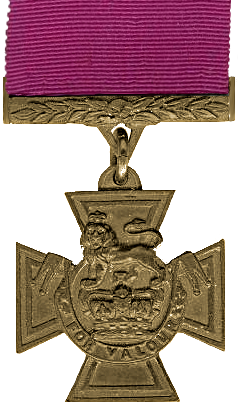
Captain Richard Wallace Annand VC, ERD, DL was an English recipient of the Victoria Cross, the highest and most prestigious award for gallantry in the face of the enemy that can be awarded to British and Commonwealth forces. This was the first VC awarded to a member of the British Army in the Second World War.
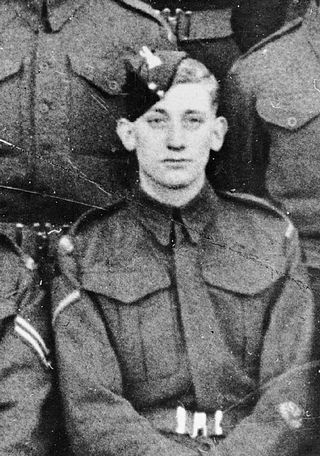
Corporal Sidney Bates VC was a British recipient of the Victoria Cross, the highest and most prestigious award for gallantry in the face of the enemy that can be awarded to British and Commonwealth forces. Upon his unit being attacked Bates charged the enemy forcing the enemy to retreat which he was hit several times and died later of his wounds.
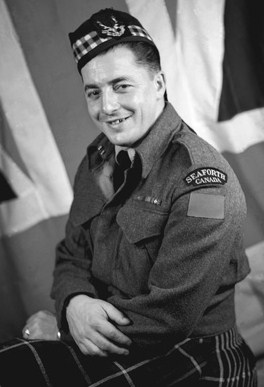
Ernest Alvia "Smokey" Smith was a Canadian recipient of the Victoria Cross, the highest award for gallantry in the face of the enemy that can be awarded to British and Commonwealth forces. He was the last living Canadian recipient of the Victoria Cross.

Brigadier Lorne MacLaine Campbell, was a British Army officer and a Scottish recipient of the Victoria Cross, the highest award for gallantry in the face of the enemy that can be awarded to British and Commonwealth forces.

Clement Robertson was a Colony of Natal-born, recipient of the Victoria Cross, the highest and most prestigious award for gallantry in the face of the enemy that can be awarded to British and Commonwealth forces.

The 11th Armoured Division was an armoured division of the British Army which was created in March 1941 during the Second World War. The division was formed in response to the unanticipated success of the German panzer divisions. The 11th Armoured was responsible for several major victories in the Battle of Normandy from in the summer of 1944, shortly after the Normandy landings, and it participated in the Allied advance from Paris to the Rhine, the Rhine crossing in March 1945. It was disbanded in January 1946 and reformed towards the end of 1950. In 1956, it was converted into the 4th Infantry Division.
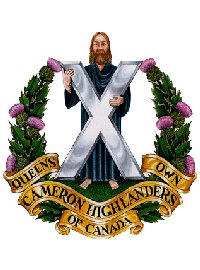
The Queen's Own Cameron Highlanders of Canada is a Primary Reserve infantry regiment of the Canadian Army. It is part of the 3rd Canadian Division's 38 Canadian Brigade Group and is headquartered at the Minto Armoury in Winnipeg, Manitoba. It is the oldest highland regiment in Western Canada.
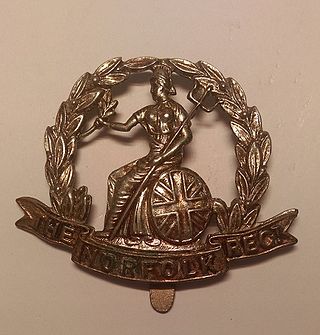
The Royal Norfolk Regiment was a line infantry regiment of the British Army until 1959. Its predecessor regiment was raised in 1685 as Henry Cornwall's Regiment of Foot. In 1751, it was numbered like most other British Army regiments and named the 9th Regiment of Foot.

The 59th (Staffordshire) Infantry Division was an infantry division of the British Army that was formed during the Second World War and fought in the Battle of Normandy. In March 1939, after Germany re-emerged as a significant military power and invaded Czechoslovakia, the British Army increased the number of divisions in the Territorial Army (TA) by duplicating existing units. The 59th (Staffordshire) Motor Division was formed in September 1939, as a second-line duplicate of the 55th Motor Division. The division's battalions were all, initially, raised in Staffordshire.

The 5th Parachute Brigade was an airborne forces formation of brigade strength, raised by the British Army during the Second World War. Created during 1943, the brigade was assigned to the 6th Airborne Division, serving alongside the 3rd Parachute Brigade and the 6th Airlanding Brigade.

Operation Spring was an offensive operation of the Second World War conducted by II Canadian Corps during the Normandy campaign in 1944. The plan was intended to create pressure on the German forces operating on the British and Canadian front simultaneous with Operation Cobra, an American offensive. Operation Spring was intended to capture Verrières Ridge and the villages on the south slope of the ridge. The German defence of the ridge contained the offensive on the first day and inflicted many casualties on the Canadians.

Operation Jupiter was an offensive by VIII Corps of the British Second Army from 10 to 11 July 1944. The operation took place during the Battle of Normandy in the Second World War. The objective of the 43rd (Wessex) Infantry Division was to capture the villages of Baron-sur-Odon, Fontaine-Étoupefour, Château de Fontaine-Étoupefour and to recapture Hill 112. An attached brigade of the 15th (Scottish) Infantry Division would take Éterville, Maltot and the ground up to the River Orne and then the tanks of the 4th Armoured Brigade, supported by infantry, would advance through the captured ground and secure several villages to the west of the River Orne. It was hoped that the initial objectives could be captured by 9:00 a.m., after which the 4th Armoured Brigade would exploit the success.

Operation Perch was a British offensive of the Second World War which took place from 7 to 14 June 1944, during the early stages of the Battle of Normandy. The operation was intended to encircle and seize the German occupied city of Caen, which was a D-Day objective for the British 3rd Infantry Division in the early phases of Operation Overlord. Operation Perch was to begin immediately after the British beach landings with an advance to the south-east of Caen by XXX Corps. Three days after the invasion the city was still in German hands and the operation was amended. The operation was expanded to include I Corps for a pincer attack on Caen.

The capture of the Caen canal and Orne river bridges was an operation by airborne forces of the British Army that took place in the early hours of 6 June 1944 as part of the Normandy landings of the Second World War. The objective was to capture intact two road bridges in Normandy across the River Orne and the Caen canal, providing the only exit eastwards for British forces from their landing on Sword Beach. Intelligence reports said both bridges were heavily defended by the Germans and wired for demolition. Once captured, the bridges had to be held against any counter-attack, until the assault force was relieved by commandos and other infantry advancing from the landing beach.

The Battle of Bréville was fought by the British 6th Airborne Division and the German 346th Infantry Division, between 8 and 13 June 1944, during the early phases of the invasion of Normandy in the Second World War.
The 176th Brigade was an infantry brigade of the British Army that saw active service in the First World War on the Western Front and disbanded in 1919. The brigade was raised again, now known as 176th Infantry Brigade, shortly prior to the Second World War and fought in the Normandy Campaign before being disbanded in August 1944. In both world wars the brigade was assigned to a 59th Division: the 59th Division during the first, and the 59th (Staffordshire) Infantry Division in the second.




















